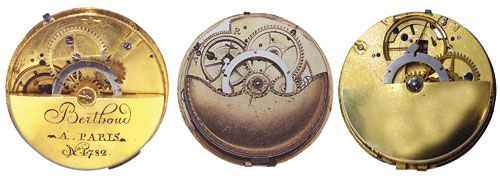
Three automatic fusée movements that were in known to exist at the end of the 20th century.
Left to right: attributed to Perrelet, signed on the rim ‘Egidius Link in Augsburg’, Berthoud.
A 73-year-old man. Proud demeanour. Suit and tie. A great day in his life. He stands in the centre of a vast room next to a table on which he has placed a retro-projector. Facing him, seated, are timekeeping ‘professionals’ – watchmakers and journalists. A tribunal of inquisition has been convened for a trial about timekeeping history. The location of the deliberations is the French Chamber of Horology, Avenue Franklin Roosevelt, Paris.
“Can we wait a little longer?” asks Joseph Flores, a little disappointed at the low turnout of people in the jury. Or, does it really matter whether the group is large or small, especially if he is to be condemned to the stake after having given his all for this demonstration? Following thirteen years of research, Flores does, however, expect to prove his case. This is precisely why he is standing here. His cause is that of Hubert Sarton of Liège (1748-1828).
Joseph Flores is a Franco-Swiss watchmaker, born in Villers-le-Lac in the French department of the Doubs, of Spanish parents. He is also a historian. In 1998, he received the Prix Gaïa, awarded by the International Watch and Clock Museum in La Chaux-de-Fonds. A self-educated man, Flores claims, contrary to the official version of history, that Hubert Sarton invented a central pivoting system called a ‘rotor’ in the 18th century.
In 1952, another historian, an ‘official’ one this time, the Swiss Alfred Chapuis, stated ‘with quasi certainty’ that the paternity of the world’s first automatic movement belongs to Abraham-Louis Perrelet. Chapuis based his belief primarily on an article that appeared in the Journal des Bijoutiers Horlogers in 1949. Perrelet was a contemporary of Sarton, and lived in Le Locle, only a few hundred kilometres from Liège. At the time, Le Locle was part of the Prussian principality of Neuchâtel, and the area was indeed a true watchmaking enclave if there ever was one.
Joseph Flores, however, is adamant that the father of the automatic movement was not Perrelet, but rather Sarton. To support his hypothesis, he points to a document, addressed in 1778 to the French Academy in Paris, which describes, in great detail, the functioning of a rotor system, along with the name of the Belgian Hubert Sarton. During this time, Liège was a major timekeeping centre. We must remember, too, that there were no patents in those days, like the ones that flourish today. The word ‘inventor’ did not mean anything other than ‘maker’. In other words, people did not go to court over questions of intellectual property.
However, that does not stop us from rendering unto Caesar the things that are Caesar’s, insists Flores, more than 200 years later. Still, isn’t this affair merely an academic quarrel today? The watch company ‘Perrelet 1777’ was launched in 1993, and claims, as part of its esteemed heritage, the invention of the rotor. It would be heresy to imply that a prestigious ‘Swiss Made’ brand might be an impostor…
Yet, our passionate promoter of historical veracity assures us that he has seen five models that correspond faithfully to the one presented to the French Academy in 1778. One is in the Patek Philippe Museum in Geneva. Can it possibly be that Alfred Chapuis is mistaken? Flores takes a deep breath and begins to explain how he thinks the misunderstanding happened.
In June, 1777, one year before the Belgian report was delivered to Paris, documents signed by H. B. De Saussure and the Committee of the Arts in Geneva make mention of a totally new watch ‘that winds itself’ and its inventor, a certain ‘Perlet’ from Le Locle. But, objects Flores, the Geneva documents give neither the address nor the first name of this ‘Perlet’, and he points out that a dozen Perrelets were known to have resided in Le Locle at the time. Even more serious, adds the opponent of the ‘Chapuis’ thesis, is that the documents provide no description of the component parts that made up this watch. Although societies generally don’t like to see their legends shattered, Joseph Flores proclaims that “history is the root of the industry”. He declares that his factual proof – the report submitted to the French Academy – should take precedence over any theory that was formulated from deductions, such as the one promulgated by the Swiss Chapuis – a theory nourished perhaps by a hidden industrial patriotism.
The grapevines were imported into Gaul by the Romans, but was it not France that has made a global reputation for wine? In the same manner, watchmaking has not always been ‘Swiss’. It was first French, English and Belgian. The controversy raised by Jean Flores is valid, but the mass was said a long time ago.
Source: February - March 2006 Issue





